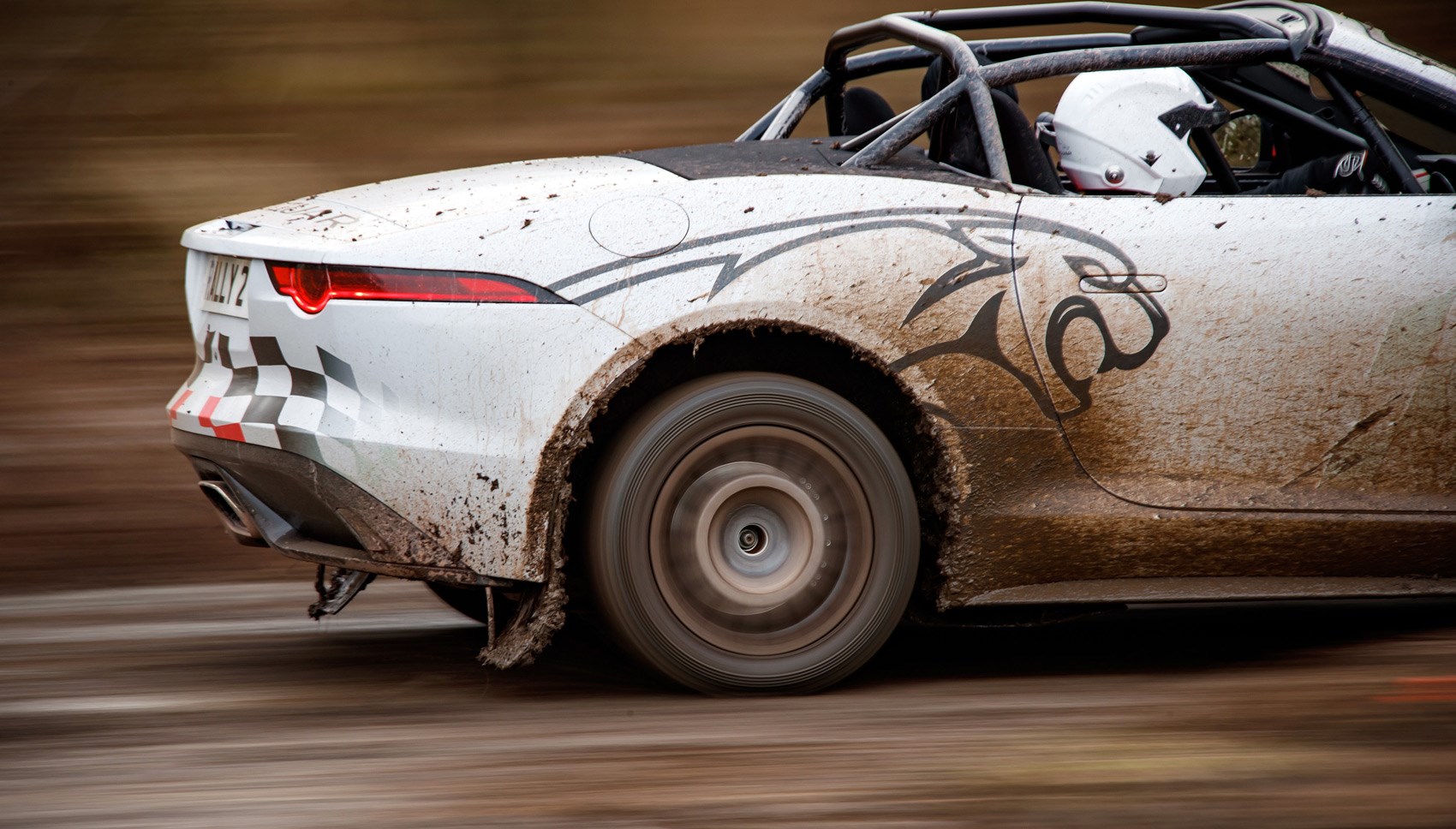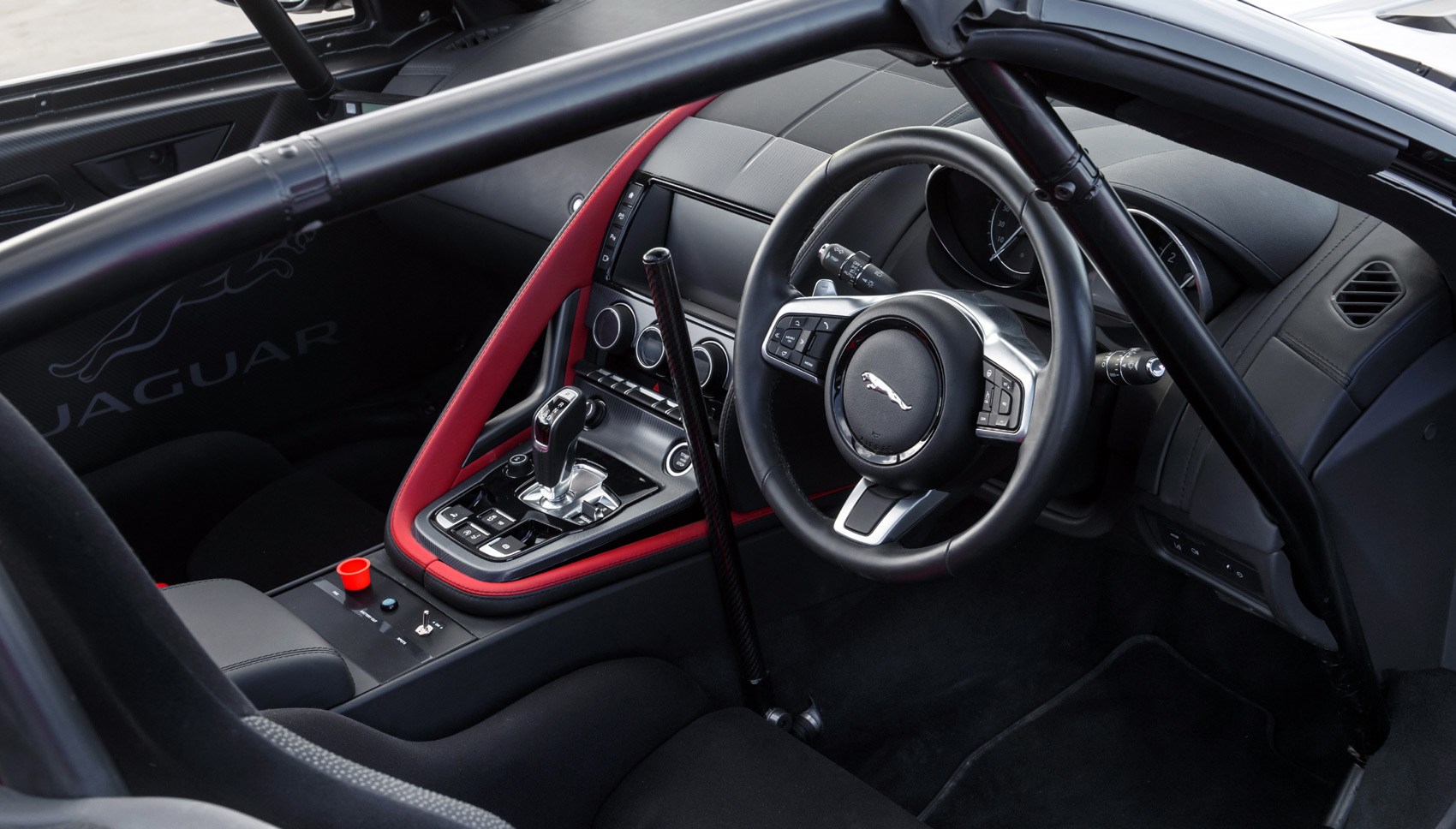► We drive Jaguar F-Type Rally
► 4cyl, rwd and FIA-spec cage
► Plus tuition from the pros
Put your PR hat on and choose one of Jaguar’s current cars to turn into a gravel-track rally weapon to show off your marque’s racing heritage – presumably you’re imagining something that already has high ground clearance and all-wheel drive, with a future-facing electric drivetrain from which you could extract maximum clickbait-zeitgeist marketing potential. An I-Pace, in other words.
Someone wearing a different hat in Coventry, however, decided that outcome wasn’t particularly Jaaaaag, and decided instead to use a low-slung, petrol-powered F-Type Convertible. Not even an all-wheel drive either, a rear driven version, because for now at least sliding sideways on dirt with flames coming out the exhaust is still cool.
There’s another reason, too: this project isn’t particularly concerned with looking towards Jaguar’s future, but to its past. It’s part of the 70th anniversary celebration of the manufacturer’s sports cars and their success in motorsport – in this case the XK 120, a rear-driven, open-top, two-seat rally car not unlike the F-Type.
Specifically, these two F-Types have been built to celebrate ‘NUB 120’, an XK 120 piloted by Ian Appleyard and wife Pat – the daughter of Jaguar’s founder Sir William Lyons. Together they completed the Alpine Rally unpenalised for three years running, before winning the cross-continental Tulip Rally and the 1953 RAC Rally of Great Britain.
Good effort. But how do you turn a Jaguar F-Type into a rally car?
The modifications to are strictly bolt-on, with the basic architecture unchanged – the rally car making good use of the F-Type’s standard all-round double wishbones.
What is new is a set of hand-built competition dampers from WRC supplier EXE-TC with three-way adjustment (compression, rebound and low-speed bypass) to allow the car to be minutely tweaked for different surfaces. Each has a remote oil reservoir to keep things cool over a long bumpy rally stage and also to allow for more suspension travel.
To that end the F-Type rally has softer Eibach springs that soak up hits and boost travel by 40mm. And because the F-Type rally sits on smaller 16-inch alloys with gravel-spec tyres it doesn’t feel lofty like an E-Pace convertible – the bonnet is only 10mm higher than the road car.
Behind those wheels are a set of 295mm grooved discs with four-piston AP Racing calipers front and rear, and a hydraulic handbrake (the standard car has an electronic one) activated with massive satisfaction by yanking a massive carbonfibre lever next to the steering wheel.
Finally, there’s the limited slip differential you get as standard on the F-Type 380 to help put down power on slippery surfaces.
Wait…what engine does this car have?
Well as you might have guessed from its inherent lack of diff, this car doesn’t have a six- or eight-cylinder lump, but the rather lither 2.0-litre i4 – because rally cars have four cylinders, and also because this liberates 50-70kg from the larger-engined F-Type’s front end. That’s half the weight of a journalist.

Less mass at the front means more agility and a better turn in, particularly in slippery conditions, while 296bhp and 295 lbs ft of torque are more than enough to get into and out of trouble on dirt.
The standard steering rack remains, as does the eight-speed automatic gearbox, although the final drive has been reduced by seven percent to improve acceleration, while the centre box has been removed from exhaust and some metal underbody armour installed in its place.
What’s the Jaguar F-Type rally car like inside?
One you’ve installed yourself within the full FIA-spec roll cage and shut the carbonfibre-trimmed door the dashboard in front of you is largely unchanged, although the view ahead is dominated by a pod containing four xenon lamps.
The standard chairs have been liberated and replaced by carbonfibre buckets with six-point race harnesses, which grip you harder than your father-in-law’s handshake. This is a good thing because the rally car has no stability or traction control, or even ABS, so you need to be plugged directly into the chassis’ movements via the seat of your pants.

There’s no complicated start-up procedure, you simply hit the starter button as usual and then press the ‘OK’ button on the wheel about a dozen times to clear all the error messages about the various driver assistance systems that are now 100% inoperable. Because they’ve been removed.
What’s it like to drive?
We’ve attended Jaguar’s Fen End facility towards the end of the week-long event and as such the tarmac sections of the short rally stage were covered in mud deposited by other drivers. There’s also a gravel section, which contained a lot of mud, and some grass that had even more mud on it. One part of the track was so muddy we were not allowed to drive on it.
Not wanting to be responsible for slithering into a bank or tree trunk in one of two specially built rally F-Types I tentatively lined up at the start cones and pulled away with the kind of delicacy you’d need employ when building a scale model of a ship. An old one, with lots of fiddly rigging and tiny sailors with intricate uniforms to paint.
Once it’s up and moving though the traction improves and some speed can be gathered, accompanied by a fantastic soundtrack piped straight through the open roof. Raw and rough and as gravelly as the surface beneath the wheels, no doubt in large part to its modified exhaust.
Turn one was a sort of chicane which required an earlier brake than you’d think – soft suspension and lack of ABS means heavy stopping results in an audible lock-up of the rear wheels. The steering is also less responsive than on tarmac and it’s not particularly fast off-centre either, but the car feels balanced and remarkably roll-free even in successive bends.
There’s a little straight next with a pothole big enough to boil stock in – I forgot about this on one run and put a wheel in it by accident, expecting it to smash the sump to bits or turn the tyre into a rotating mass of shredded rubber, but the long travel suspension soaked the impact up like kitchen roll.
The gravel section came next and consisted of a long left-hander that with a degree of skill and deftness of touch could conceivably be negotiated in one yawning powerslide – the rear end of the F-Type lets go inch-by-inch in a seemingly linear response to the openness of the throttle and the front wheels track the loose surface as if it was tarmac thanks to those grippy tyres, finally given a surface to bite into and in their element.
Next there were some more tarmac straights and chicanes and then a mud circle to whip the back end around before it’s back-the-way-you-came and please-don’t-crash-into-the-pit-garage.

There was only one trouser troubling moment – I was approaching a fast right-hander onto a straight, when I reasoned I could carry more speed if I stayed left to open the turn up and take a later apex. As the tyres left the reasonably muddy tarmac cleared by many repeated passes and touched very muddy tarmac, the front end let go and we found ourselves pushing wide towards some foliage, me trying to remember to let the brakes off every time they locked.
Enter some stereotypically concise but timely analysis from Finnish rally-legend Minna Sillankorva who was sat to my left: ‘That was the wrong line’. Yes. Yes, it was.
Verdict
It’s only early in 2019 but I suspect I’m going to have to try quite hard to find something more thrilling than a rear-wheel drive Jaguar F-Type rally car this year.
The sad thing is you obviously can’t buy one, but if you were so inclined you could reasonably follow Jaguar’s recipe and make one yourself.
Should you? Absolutely. Should Alpine’s engineers at Dieppe do the same with the A110? Also absolutely.
Check out our Jaguar reviews